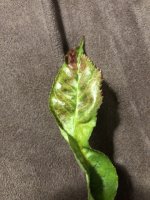You are using an out of date browser. It may not display this or other websites correctly.
You should upgrade or use an alternative browser.
You should upgrade or use an alternative browser.
Fruit Dwarf peach tree needs help
- Thread starter parsonswife
- Start date
parsonswife
Veteran Member
2 years oldHow old is the peach tree?
I only ask, because it seems like in our AO a peach tree only last for about 10 years.
We gotta replant several.
bracketquant
Veteran Member
Hopefully your peach tree is now doing OK.
If it has a true dwarfing rootstock, the tree will likely need to be anchored. Years later a heavy fruit set can uproot the tree, otherwise.
Also, any pruning should be "summer pruning". In my area, that will be for the next couple of weeks.
If it has a true dwarfing rootstock, the tree will likely need to be anchored. Years later a heavy fruit set can uproot the tree, otherwise.
Also, any pruning should be "summer pruning". In my area, that will be for the next couple of weeks.
Raggedyman
Res ipsa loquitur
that is an excellent point - I've had it happen here with apples. the other extreme is that roots can become rotted by too much rain and persistently "wet feet". it that's the issue you may need to consider "root pruning".Hopefully your peach tree is now doing OK.
If it has a true dwarfing rootstock, the tree will likely need to be anchored. Years later a heavy fruit set can uproot the tree, otherwise.
Also, any pruning should be "summer pruning". In my area, that will be for the next couple of weeks.
avoid any and all top pruning and instead, “root prune” in fall after dormancy. I'd also suggested to avoid fertilizing any trees over five years old.
the tree must be completely dormant. go out to the drip line and with a spade, dig down as deep as the spade with the intention of severing roots in a circle completely around the tree.
I would also suggest a bit of Internet research for further direction.
bracketquant
Veteran Member
Semi-dwarf rootstock basically solves the problem. And while the tree would likely want to grow larger than a dwarf, pruning can keep the semi-dwarf the same size as the dwarf. Summer pruning, rather than fall, winter or early spring pruning, prevents water sprouts. And water sprouts means another round of pruning, far more laborious than the initial pruning.
parsonswife
Veteran Member
What are water sprouts?Semi-dwarf rootstock basically solves the problem. And while the tree would likely want to grow larger than a dwarf, pruning can keep the semi-dwarf the same size as the dwarf. Summer pruning, rather than fall, winter or early spring pruning, prevents water sprouts. And water sprouts means another round of pruning, far more laborious than the initial pruning.
bracketquant
Veteran Member
Epicormic branching is the scientific term. They are shoots that grow up fast from branches, and from the base of the tree (suckers). They usually occur after tree damage or pruning. They are mostly undesirable because of the fast growth, making the tree more dense. That produces less light penetration throughout the crown. And, they mostly produce smaller inferior fruit. Especially on a dwarf tree, which are usually chosen for a compact size, the water sprouts aren't wanted. If a tree had a fairly large open area, because of broken branches, perhaps a few water sprouts would fill in that area OK.What are water sprouts?
winodog
The Bible is a flat earth book
My trees need pruning but theres still fruit on them. Is it wise to cut those water spouts now? It would help so I can put bird netting up.Semi-dwarf rootstock basically solves the problem. And while the tree would likely want to grow larger than a dwarf, pruning can keep the semi-dwarf the same size as the dwarf. Summer pruning, rather than fall, winter or early spring pruning, prevents water sprouts. And water sprouts means another round of pruning, far more laborious than the initial pruning.
bracketquant
Veteran Member
I only summer prune, so have never had to deal with water sprouts.My trees need pruning but theres still fruit on them. Is it wise to cut those water spouts now? It would help so I can put bird netting up.
I look at pruning as more of an art form rather than a pure science. Each tree is different, and may need different applications/shaping. The key when learning to prune, is to go slow initially. In pruning your water sprouts, I would recommend just taking off what is needed to make the bird netting go on easier, this year. If you have water sprouts in the densest part of the tree, with basically no fruit on them, those should probably go first. The following year(s) you can decide how much more to prune, and find out what time of year to do it.
With my own trees, I thin a bit more on the southern side than on the northern side, as that's where the sunlight penetrating into the crown comes from. I don't know if anyone else does this, and have never read about it. I only learned that pruning lets in more light, and I went from there.
Perhaps the best lesson is that...
one can always cut off, but never add back.

